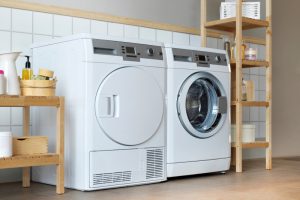
Gathering the family together to share a meal is an important part of maintaining good communication inside a busy household, and a candle-lit dinner for two might be just the thing to rekindle an intimate spark. But not if the lively conversation or sweet nothings are being drowned out by the buzzing, knocking, clicking, or squealing of a noisy refrigerator. Why is the fridge making such a racket?
Five reasons your refrigerator is so loud
While the origin of the noises emanating out of your normally dependable kitchen appliance might seem mysterious, there are some very specific reasons why a refrigerator will become loud when running. Listed here are the five most common ones:
- Damaged Fan Blade – Refrigerators have two fan blades. The very first is a condenser fan blade mounted on the condenser fan motor which draws in air from the front of the refrigerator, sends it beyond the condenser coils (which helps to dissipate heat in the coils created by the condensing from the appliance's refrigerant in gas form into a hot liquid), and then circulates the environment back out through the grill. The second is an evaporator fan blade mounted on the evaporator fan motor. This fan blade draws air in the refrigerator compartment into the freezer compartment and past the evaporator coils which are chilled by the refrigerant in liquid form being expanded back to a gas. The cold evaporator coils remove the heat from the air that is then recirculated back into the refrigerator compartment. With use, the condenser fan blade or even the evaporator fan blade can become damaged or dislodged and begin scraping against a panel or mounting bracket as they rotate. The result will be a squeaking or squealing sound whenever the fan motor is operating.
- Defective Evaporator Fan Motor – Independent of its fan blade, the evaporator motor itself might be defective and become considerably noisy during operation. This is often caused by the failure from the motor bearings, resulting in a grinding or clicking sound.
- Malfunctioning Condenser Fan Motor – As with the evaporator fan motor, the bearings within the condenser fan motor can fail as well. Again, a malfunctioning condenser fan motor will create a grinding or clicking sound when the fan motor is running.
- Worn Out Compressor – The compressor may be the component that pumps the refrigerant with the evaporator and condenser coils to cool the refrigerator and freezer compartments. A maturing compressor can become quite noisy and will make a knocking or buzzing sound because it nears the end of its life.
- Faulty Water Inlet Valve – The water inlet valve controls water being supplied to the dispenser and the refrigerator's icemaker. If the refrigerator is especially noisy when the icemaker is filling, then it's likely the inlet valve is malfunctioning. With time, mineral deposits can build-up in the valve, creating a restriction which can cause a squeaking or rattling sound.
Can I repair the fridge myself to quiet it down?
Most parts which can cause a refrigerator to become noisy or loud are easily replaceable by a do-it-yourselfer. All it takes is several common household tools, such as a screwdriver and pliers, and a little patience.
The evaporator fan motor and its fan blade are normally located at the back of the freezer compartment behind a number of panels, although some models will mount the evaporator assembly behind a rear panel within the refrigerator compartment. You will usually need to remove the shelving and drawers in the compartment (and, potentially, the icemaker assembly) in order to uninstall the rear panel or panels. An evaporator fan blade can be pulled off the motor shaft along with a new one slid on. The motor is usually secured to a bracket with two screws and can have two power wires attached or perhaps a wire connecter. Unthread the screws and detach the wires to get rid of the old motor; attach the wires towards the terminals on the new motor, or reconnect the wire connecter, and rethread the mounting screws to secure the motor towards the bracket.
The condenser fan motor and accompanying fan blade can usually be found near the bottom of the refrigerator behind a cardboard or metal access panel attached to the lower rear of the appliance. You will need to pull the refrigerator away from the wall to reach the panel. You may need to detach a water supply line before you uninstall the access panel (make sure to close the water supply valve before doing this!). As with the evaporator fan motor, the condenser fan motor will likely be secured to a bracket with mounting screws and will also be powered through two separate wires or a wire connecter.
The refrigerator's water inlet valve is also normally located near the bottom of the appliance behind the lower access panel. After treatment of incoming water supply line, you will need to unthread the screws securing the old component, then disconnect the wire connecters and release the outgoing water lines from the valve. You may have to remove a locking clip before depressing the retaining ring to release a line. Insert the lines into the new inlet valve, connect the wire connecters, then thread the screws to mount the valve towards the bracket or to the frame from the refrigerator. Reinstall the access panel and secure the incoming water supply line towards the valve. Be aware that you should replace a small water inlet valve with a new valve instead of attempting to cleanse an obstruction, since the damage caused by the initial restriction puts the part in a greater risk for failure in the future.
What about the refrigerator's compressor? That repair is not recommended for a do-it-yourselfer. You should have a licensed technician inspect and switch the compressor if necessary.
Find the right refrigerator parts with Repair Clinic
Whether you have to replace an evaporator fan motor, condenser fan motor, fan blade, water inlet valve, or other refrigerator component, the first step would be to identify the specific part that works with your model. Repair Clinic makes this step easy. All you have to do is go into the full model number of the appliance in the Repair Clinic website search bar to see a complete list of compatible parts. After that you can use the part category and part title filters to narrow that jot down to locate the exact part you'll need, including those that fit KitchenAid, GE, Kenmore, LG, Samsung, Frigidaire, Maytag, and Whirlpool models.

















